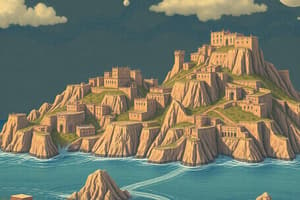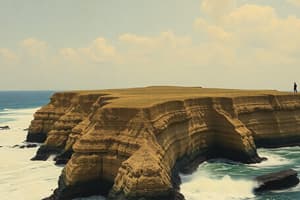Podcast
Questions and Answers
What are the two main categories of coastal processes?
What are the two main categories of coastal processes?
- Marine and terrestrial processes (correct)
- Wave action and erosion
- Mass movement and deposition
- Transportation and weathering
Destructive waves are beach builders.
Destructive waves are beach builders.
False (B)
What are the three factors that determine the height and strength of a wave?
What are the three factors that determine the height and strength of a wave?
The fetch, the amount of time the wind blows, and the strength of the wind
The movement of water up the beach is called the _______________.
The movement of water up the beach is called the _______________.
Match the following types of waves with their characteristics:
Match the following types of waves with their characteristics:
What happens to a wave as it approaches the coast and enters shallower water?
What happens to a wave as it approaches the coast and enters shallower water?
Flashcards are hidden until you start studying
Study Notes
Coastal Processes
- Coasts are an open system with inputs (sediment), transfers (longshore drift), stores (beach), and outputs (water)
- Coastal processes are divided into two parts: marine processes (offshore, water-based) and terrestrial processes (onshore, land-based)
Wave Action
- Waves are marine processes that erode, transport, and deposit material
- Waves are formed by winds blowing over the surface of the sea
- The height and strength of a wave depend on three factors:
- Fetch
- The amount of time the wind blows
- The strength of the wind
- The greater the strength, time, and fetch of the wind, the larger the wave
Wave Characteristics
- As a wave approaches the coast and enters shallower water, friction from the sea bed causes the wave to lean forward and eventually crest and break onto the beach
- The movement of water up the beach is called the swash, and the return movement is the backwash
Types of Waves
- There are two types of waves:
- Destructive waves: erode the beach
- Constructive waves: are beach builders
Comparison of Wave Types
- Constructive waves:
- Swash: weak
- Backwash: weak
- Wavelength: long with low height
- Frequency: low (6-8 per minute)
- Type of beach: sandy, depositional
- Destructive waves:
- Swash: strong
- Backwash: strong
- Wavelength: short with high height
- Frequency: high (10-12 per minute)
- Type of beach: shingle, erosional
Studying That Suits You
Use AI to generate personalized quizzes and flashcards to suit your learning preferences.




